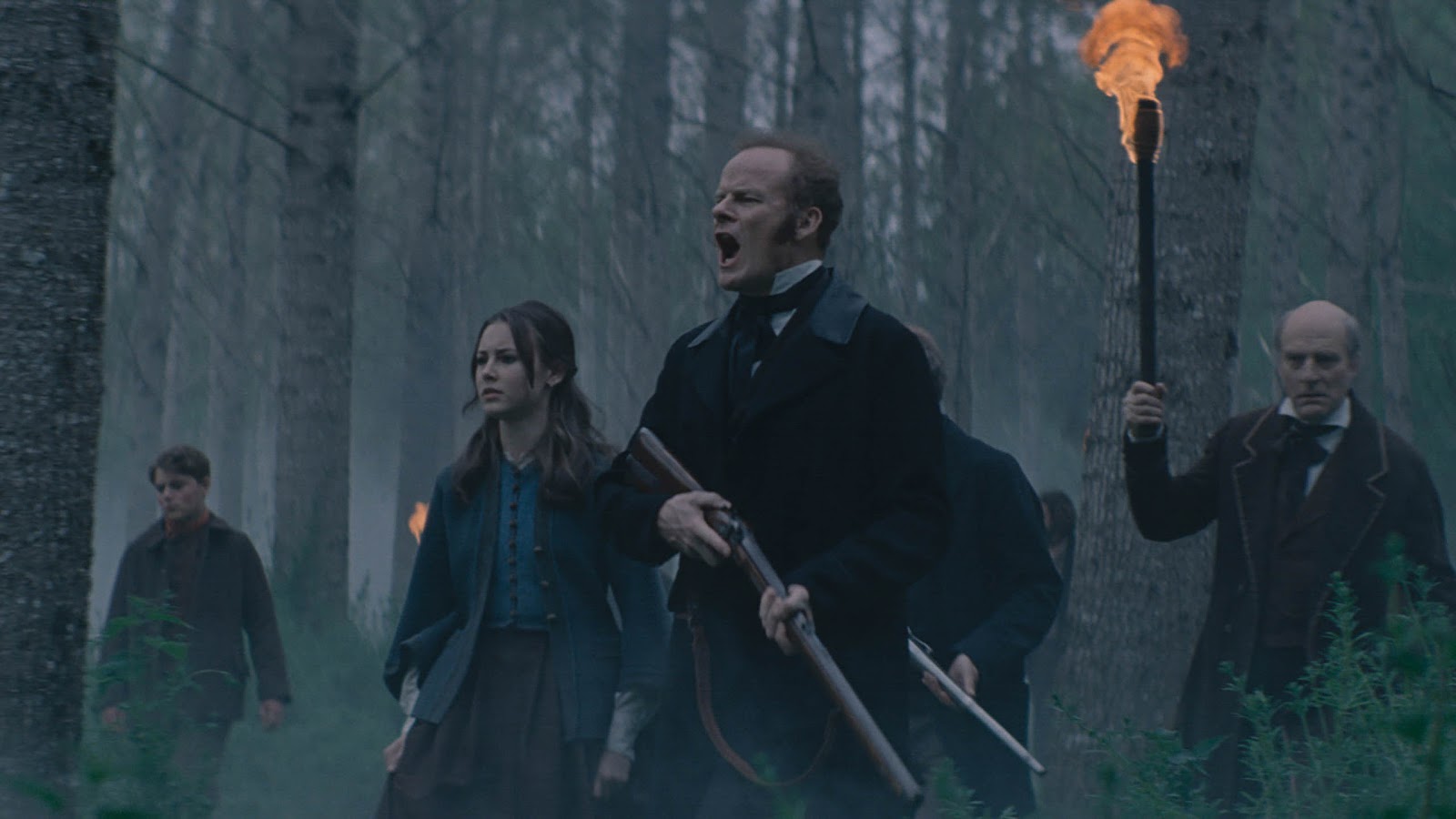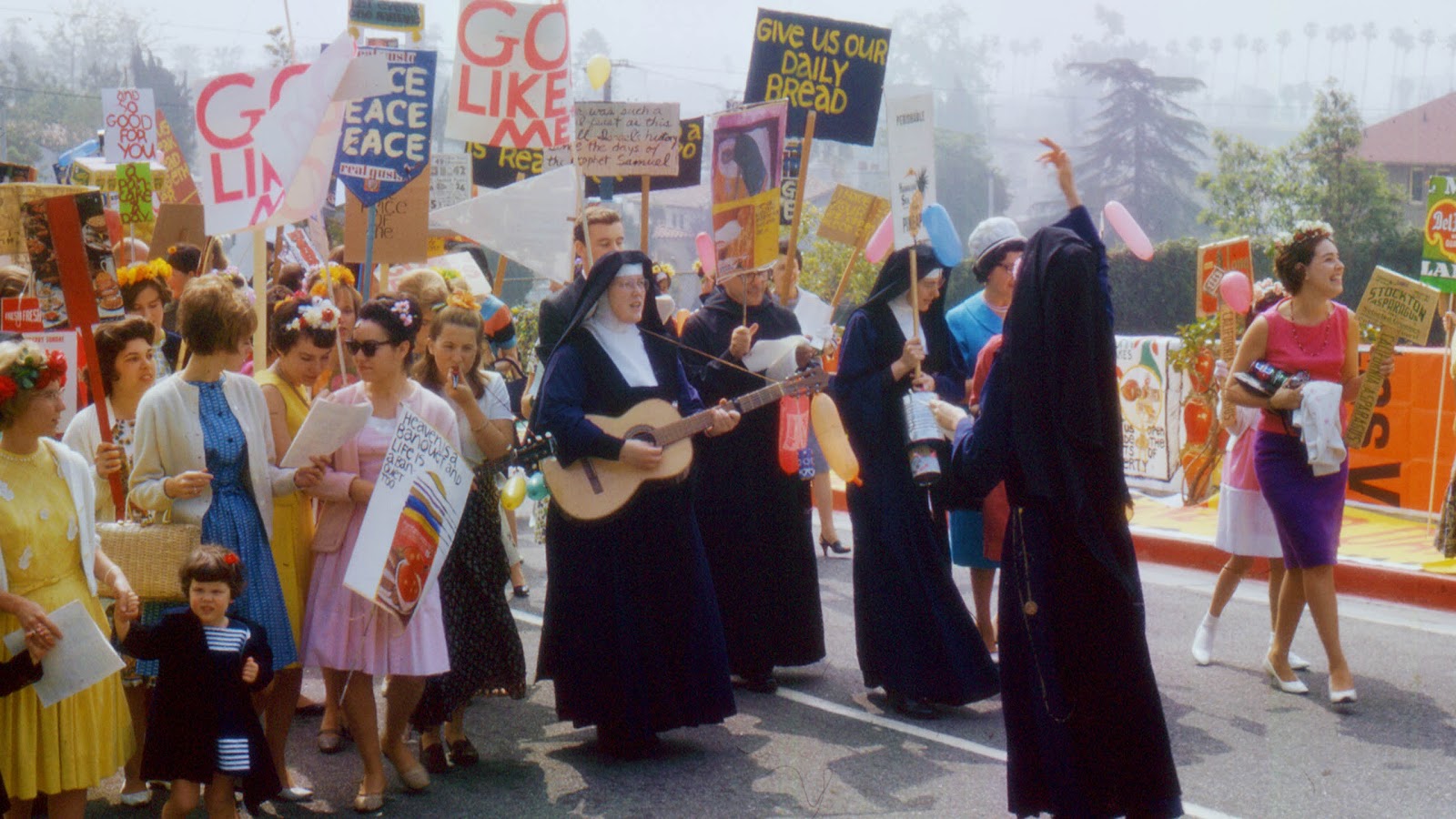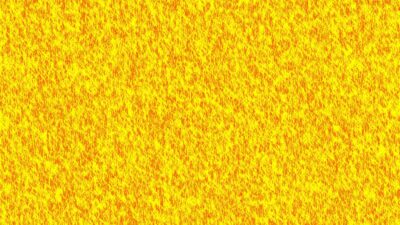Merry-Go-Round Magazine is still at the 2021 Sundance Film Festival!
There’s been a fascinating thread of programmed choices either directly or indirectly centering themselves on our current predicament. Of course, it’s a programmer’s dream to launch a thematically connected series, and perhaps the 2019 filmmaker hive mind really was braced for the worst, their predictions of the apocalypse lining up with the real one by pure happenstance. Or, maybe these filmmakers are deliberately removing themselves from a “my movie is about COVID-19” media narrative and just saying “Oh, well, haha, you know, crazy enough we came up with the idea before COVID.” Regardless, some of these flicks, though relevant, are starting to wear us down. We remember the pandemic! We’re still in it! Luckily, Sundance is still here to provide one of the funnest parts of any festival: the variety.
We watched the anti-establishment nuns of Pedro Kos’ REBEL HEARTS, Argentine satire in Ana Katz’s THE DOG WHO WOULDN’T BE QUIET, and man-mangling werewolves in Sean Ellis’ EIGHT FOR SILVER.

EIGHT FOR SILVER
Director: Sean Ellis
In a WWI medical tent, a British troop is gushing blood as the doc extracts a battalion’s worth of German bullets. One’s a real bugger, shattered and deep in his guts: the medic dives in with rusty forceps and removes a silver bullet, still as sterling as any piece of jewelry. We open with a clever mix of lore-building and preparation for how casually bodies are about to be dismantled in Sean Ellis’ EIGHT FOR SILVER, or, sure, THE VVWEREVVOLF. I’m goofing, but just swap Eggers’ perceived dangers of a burgeoning femininity in a puritanical nation with revenge on England for exterminating the Romani and you get the idea of Ellis’ approach; harping on a cycle of curses, righteous vengeance making way for genocidal cleansing, forever to be repeated in the annals of our sordid history as a world’s people. Ellis depicts the pillaging of a tent village, referred to as “expunging the gypsies,” by the lords who deem their roaming presence on the countryside an infestation, in an unbroken shot from atop a hill, followed by the Englishmen posing with the slaughtered corpses like trophies. One victim is punished by having his hands and feet lopped off with a dull axe, hoisted as a scarecrow. Before being buried alive, the final survivor summons a curse on the land, one that produces an all-consuming beast on the prowl. The ‘60s and ‘80s produced a lot of tripe like this, where those who lived atop the Indian burial grounds were seen as the victims, but EIGHT FOR SILVER is an angry movie hungry for the POLTERGEIST family’s demise. Coincidentally set during the Cholera pandemic amidst violent international and domestic relations, where the workers board up the aristocracy’s windows but are left out in the green to hang up freshly washed laundry, you’ll be hungry, too.
A tween boy puts on some haunted silver grills and bites a brat’s neck clean off; later, he has his arm GREEN ROOM’d to shit and is found mutilated in a cavern with his faculties mauled beyond recognition. The children of the colonizers are the first course, haunted by the ills of their parents on some A NIGHTMARE ON ELM STREET murder logic. This is a nasty bit of genre work, gothic in its sense of place, but not in the ornateness we’ve grown accustomed to. There’s a crucial blandness flavoring EIGHT FOR SILVER’s locales, the primary manor under lupine fire so plainly milquetoast and primed for a splash of crimson red. Boyd Holbrook (THE PREDATOR defender has logged on) is called upon to the town as a werewolf Van Helsing, and his turn is a strong reminder that he’s a gem out of all the white leading men who look like *that*. He suffers from accursed daily nightmares of a Slender Man-looking Romani abducting his family, only to startle awake with jump-scares: Ellis is clamoring for a chance at a CONJURING spin-off that he will very likely get.
The film takes inspiration from Carpenter’s most intergalactic terrors, its carnage from some of Romero’s most brutally felt flesh-tearings, but the shitty vaseline-smeared blur special effect for the werewolf attacks, implemented to draw attention from the mid-level digital effects work on the beasts, is at the expense of visual comprehensibility. Someone needs to go back into the project file and delete it immediately. EIGHT OF SILVER is at its prime when letting loose on all cylinders, its shaggy first act begging for a trim; it just needs anything that bridges us closer to the flaming fucking stallions in the ambitiously scaled final massacre that, though admirable, bites off more than the make-up and VFX teams can chew. But the energy is there. Ellis is registering at a nearly self-parodical moodiness, impressively laying waste to all life while letting you jeer and laugh at just how aggressive he’s willing to go about indicting the empire from whence this violence came. Holbrook implores the young boy who opened Pandora’s box that “none of this was your fault, son,” propagating another generation of colonizers innately incapable of recognizing the wicked weight of their fathers’, their mothers’, and their own inflicted lesions. Wolf eating its own tail; rad shit. [Kevin Cookman]

REBEL HEARTS
Director: Pedro Kos
Anti-establishment nuns take center stage in REBEL HEARTS, a documentary detailing the little-known story of The Sisters of the Immaculate Heart convent’s fight for freedom in the late 1960s. Sister Corita Kent and other less known activists are profiled in this talking-heads style story focusing on the events from 1962 -1970 and the political showdown between Cardinal James Francis McIntyre of the Los Angeles diocese and the sisters who dared to go against him. These women were anti-habit and pro freedom of speech, and once the Catholic Church determined the women were enjoying too much intellectual and political freedom, they locked it down and expelled the women from the church. Using mainly archival footage, news reports, and recordings of official convent meetings from the period, director Pedro Kos is able to present a complex tableau of these women and their unique vision for change not only within the confines of their community, but the world at large. We see one of the sisters marching alongside civil rights activists in Selma, Alabama and others in Vietnam protests. The utopian nun-run Immaculate Heart College feels too good to be true, and we know, much like the same decade’s Summer of Love, it’ll all come crashing down soon. Peak euphoria can be felt at the midpoint during Mary’s Day; it’s as though we’ve been transported into a vivid psychedelia reserved for a San Francisco-style “Be-In” and anything is possible. Sister Korita, well known serigraph artist, is of course profiled and discussed throughout the film, and her pieces convey this dynamism of the sisters and the moment of the late 1960s: who knew that the Catholic Church could be so radical?
Nuns are usually viewed as a monolith, and Pedro Kos’ approach is considerate to ensure that a diverse array of the nuns’ stories are told, rather than just a celebrity like Kent. It’s this championing individuality juxtaposed with the Catholic Church’s cold commodification of female labor that elevates an otherwise sunny story. Regardless of the industry, the humanity of the workers gets overlooked. Kos employs animation to show the impact of the systemic failures of McIntyre’s vast parochial school system, with habit-wearing nuns coming off an assembly line to teach in overcrowded schools. These poor working conditions, mixed with a lack of education, inspire the women to demand more freedoms and experiment with a string of progressive-adjacent orders from the Vatican.
Feminism runs throughout; something that shocked me based on existing bias towards the church was how women sought to join for anti-establishment reasons. Several of the nuns took their vow to escape the domestic, patriarchal life expected of women. The “problem with no name” was a key consideration in becoming a nun. My own grandmother received her master’s degree from Immaculate Heart College in 1968, and she was an extremely passionate alumna. My mother says that it was due to the safe space of an all-female environment providing an arena to express her views and fight for progressive causes. While puritanical life within the church was perhaps not entirely free, Immaculate Heart College encouraged extreme autonomy and provided a haven for women to question authority. Labor politics, feminism, and artistic expression are concepts rarely attributed to organized religion, and REBEL HEARTS flips that perception on its head. [Hilary Jane Smith]

THE DOG WHO WOULDN’T BE QUIET
Director: Ana Katz
We’re all starting to get fed up with the gig economy, and that annoyance is just now starting to seep into our global media. Between Ken Loach’s SORRY WE MISSED YOU and Ana Katz’s THE DOG WHO WOULDN’T KEEP QUIET, we see how one tiny, seemingly insignificant factor can utterly destroy a working class person’s day, livelihood, and trajectory for getting out of their unfortunate circumstances. In this case, it starts with a man bringing his dog to work because the neighbors can’t stand the barking, thus losing his job in the process. Much like a dog chasing its tail (see what I did there?), it’s a cyclical experience of gain and loss and it never gets less crushing. So when even bigger catastrophes start to take place, like a meteor crashing to Earth or, I don’t know, a global pandemic, you almost need to resign yourself.
Like another Sundance 2021 release, THE PINK CLOUD, THE DOG WHO WOULDN’T KEEP QUIET suffers from chilling coincidence: a man’s world and family is rocked by a pandemic and now has to wear a bubble helmet. Either all these directors are colluding with Nostradamus or the Sundance programming team really thought, “Let’s try a social experiment to see if COVID-fatigued audiences will actually like these isolation films.” I still don’t know what the answer is—audiences seem pretty divided. We watch our middle-aged protagonist, Sebastian, uproot his life with no direction, but with hopes of making a better life for himself, his loyal furry companion, and his eventual child. The scope of his personal journey through the film is expansive; director Ana Katz stitched several years of footage together, letting the film revolve around specific emotionally-driven moments as if they were vignettes. The skips through time can be confusing at first, but then again, as we’ve learned through this pandemic, time is just a construct. A quiet, personal film that also makes a profound political statement about moving forward regardless of a lack of privilege, THE DOG WHO WOULDN’T KEEP QUIET is one that I hope to revisit in the future. I could see this film playing at a museum somewhere, with each vignette acting as its own unique piece.
Also, this dog is a very good boy. Give him a treat. [Lauren Chouinard]
















Comments